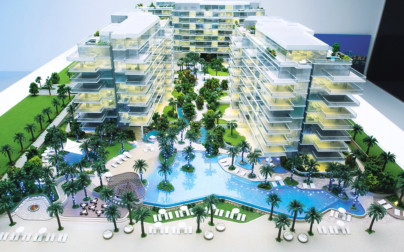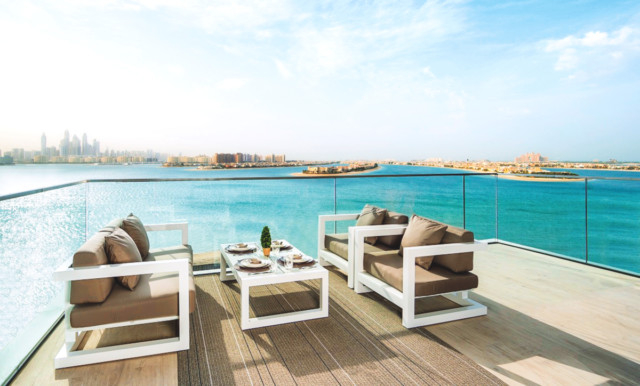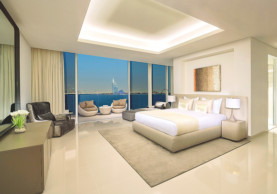
Nestled on the East Crescent of the Palm Jumeirah, Serenia Residences is a community consisting of three mid-rise buildings that feature an abundance of natural light. Developed by Palma Holding, in partnership with Banian, Serenia Residences’ elegant design is the creation of Hazel Wong. Her knack for timeless designs and capturing as much natural light as possible was of prime importance to the project, which Kareem Derbas, CEO of Palma, describes as a “masterpiece”.
Widely known for her work on the iconic Emirates Towers on Shaikh Zayed Road, Wong was therefore a perfect fit for Serenia, says Derbas. The two had also earlier collaborated on Silverene, a Palma project in Dubai Marina.
“She did a spectacular job,” says Derbas. “It is probably the most successful
Marina project, commanding the highest premiums in terms of rent and sale prices.
Hazel stays involved, and even today helps us with choosing landscaping tiles,” says Derbas. “Serenia is sophisticated luxury but also simple. We looked for contemporary elegance, letting in light for the apartments to feel very fluid and natural.”
Serenia uses panels that don’t block light from the slightly tinted windows, retractable glass that converts the living room into an outdoor area, natural materials for kitchen and doors, and reconstituted stone with shell inlay to mimic the white beach. “We wanted a serene, airy, resort-type of place with views and a blank canvas for people to decorate,” says Derbas.
Serenia features one- to three-bedroom apartments, including units with gardens, and penthouses. Amenities include a 50m Olympic pool, which overflows on to the beach and curls around the development like a lagoon.
“The design of Serenia explores the full potential of this Palm crescent site, creating a signature resort identity,” says Avinash Kumar, senior associate at British architectural firm Godwin Austen Johnson, a consultant of the project. “The creation of a continuous flow of form and space provides both a stimulating physical and visual experience.”
Pricing
The homes cost on average Dh2,500 per square foot, while larger units start at Dh3,000 per square foot, depending on the views.
“Very few don’t have a direct view and even those in the back can still see the water, thanks to the way the three buildings have been designed,” says Derbas.
With its price point and unique location, Derbas says Serenia is attracting end users, including those looking for a permanent home as well as those in search of a holiday or weekend home.
“People from Abu Dhabi and even those in Dubai who live further in the desert can have their own kitted-out getaway by the beach, instead of having to book a hotel room,” says Derbas. “And those buying larger units wanted an upgrade from older buildings.”
Derbas says the development is on track for completion by year end, with contractor Khansaheb ahead of schedule by six weeks. Over 60 per cent of the units have been sold since Serenia was launched in May 2015. “The strategy was to sell half the project, show people what it is really about and then get a better premium on the price, launching the second phase with a show apartment ready,” says Derbas. “Hopefully, the first homeowners should move in by January.”
Secured asset
Palma will manage the building, which Derbas says is designed for easy maintenance. “I think we sold Dh.5 billion in a month at launch in a tough market because we have proven with our other projects — like Silverene, which is five years old and still looks brand new — that we look after our buildings,” he says. “We don’t manage for profit; the management fee is very minimal. It is more about maintaining the quality of the asset.”
Derbas does not fret about demand fluctuations. “Obviously sales have been much slower than maybe two years ago, but we’re still selling as we’re kind of protected by offering a beachfront lifestyle. If we have unsold units we’ll keep them. We’ve done that before.
“We’ve sold enough to allow the project to complete. The rest is just to increase our capital, but if it’s not being sold at the right price, we’ll rather rent out the smaller units for a couple of years and sell them in the right market. For the [remaining] bigger units, we’ll probably wait as we wouldn’t want their value to reduce by having them potentially damaged.”














